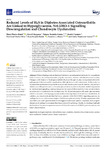Reduced levels of H₂S in diabetes-associated osteoarthritis are linked to hyperglycaemia, Nrf-2/HO-1 signalling downregulation and chondrocyte dysfunction

View/
Use this link to cite
http://hdl.handle.net/2183/30471
Except where otherwise noted, this item's license is described as Creative Commons Attribution 4.0 International License (CC-BY 4.0)
Collections
- Investigación (FCS) [1293]
Metadata
Show full item recordTitle
Reduced levels of H₂S in diabetes-associated osteoarthritis are linked to hyperglycaemia, Nrf-2/HO-1 signalling downregulation and chondrocyte dysfunctionAuthor(s)
Date
2022-03-25Citation
Piñeiro-Ramil M, Burguera EF, Hermida-Gómez T, Caramés B, Oreiro-Villar N, Meijide-Faílde R, Blanco FJ, Vaamonde-García C. Reduced levels of H₂S in diabetes-associated osteoarthritis are linked to hyperglycaemia, Nrf-2/HO-1 signalling downregulation and chondrocyte dysfunction. Antioxidants (Basel). 2022 Mar 25;11(4):628.
Abstract
[Abstract] Different findings indicate that type 2 diabetes is an independent risk factor for osteoarthritis (OA). However, the mechanisms underlying the connection between both diseases remain unclear. Changes in the balance of hydrogen sulphide (H₂S) are thought to play an important role in the pathogenesis of diabetes and its complications, although its role is still controversial. In this study, we examined the modulation of H₂S levels in serum and chondrocytes from OA diabetic (DB) and non-diabetic (non-DB) patients and in cells under glucose stress, in order to elucidate whether impairment in H₂S-mediated signalling could participate in the onset of DB-related OA. Here, we identified a reduction in H₂S synthesis in the cartilage from OA-DB patients and in cells under glucose stress, which is associated with hyperglycaemia-mediated dysregulation of chondrocyte metabolism. In addition, our results indicate that H₂S is an inductor of the Nrf-2/HO-1 signalling pathway in cartilage, but is also a downstream target of Nrf-2 transcriptional activity. Thereby, impairment of the H₂S/Nrf-2 axis under glucose stress or DB triggers chondrocyte catabolic responses, favouring the disruption of cartilage homeostasis that characterizes OA pathology. Finally, our findings highlight the benefits of the use of exogeneous sources of H₂S in the treatment of DB-OA patients, and warrant future clinical studies.
Keywords
Hydrogen sulphide
Osteoarthritis
Type 2 diabetes
Chondrocytes
Inflammation
Nuclear factor-erythroid 2-related factor-2
Heme oxygenase-1
Osteoarthritis
Type 2 diabetes
Chondrocytes
Inflammation
Nuclear factor-erythroid 2-related factor-2
Heme oxygenase-1
Editor version
Rights
Creative Commons Attribution 4.0 International License (CC-BY 4.0)
ISSN
2076-3921






